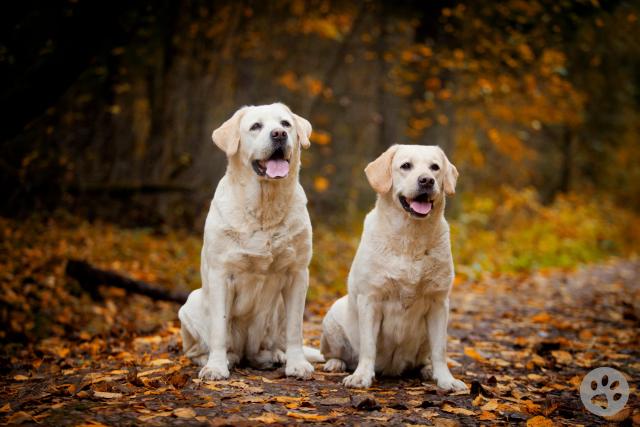Overview
Originally from Newfoundland in Canada, the early dogs were used to jump into icy waters to retrieve fishermen’s nets. Brought back to England in the early 1800s by hunters or explorers, they were given the various names of Black Water Dog, the Lesser Newfoundland, and the St John’s Dog. They were noted for their exceptional retrieving abilities, and were eventually crossed with other sporting type breeds to produce the Labrador which is known today.
Breed Characteristics
The Labrador is well-known as a popular family pet, and also for its love of food and eating (of edible food or otherwise!) They are a big, friendly breed with a tail capable of swiping a coffee table clear, or knocking small children down. As their name suggests, they love retrieving and are a popular gundog, used for picking up pheasants and other game. They love water and swimming, and will always find the muddy puddles on a walk.
Appearance
The Labrador can be found in a variety of colours and tend to be known as a black Lab, a chocolate Lab, a yellow Lab, and less-common, a red Lab. The coat is short and flat, but dense and double-layered, making it the ideal coat for this water-loving breed. They are a solid dog, with strong legs and a sturdy body, especially as their love of food can contribute to an even sturdier body. They have big, broad heads, and a strong, long tail with a broad base and well-rounded all the way to the tip, giving to the nickname; ‘Otter’s Tail’. Their ears are naturally floppy.
Size
Male Labradors stand at around 22 – 24 inches in height, whilst the female will be slightly smaller at 21 – 23 inches at the wither. The adult Labrador weighs around 30 – 32 kgs for the bitches and 31 – 36 kgs for an adult male.
Life Expectancy
Most Labrador Retrievers reach around 10 to 12 years in life expectancy; however, some will reach around 14 years of age.
Personality
The Labrador is well-known as a friendly, happy breed of dog, with a need to please people, and loves nothing more than being part of a family. They are intelligent and easy to train, and with their love of water and retrieving, make an excellent and highly-popular gundog. They will often chew or ‘mouth’ people or objects due to their need to carry an item in their mouth, therefore it helps if they are given their own toys to carry around, so their mouths are always ‘full’! They love food and will eat a variety of edible and non-edible foodstuffs if given the chance. They are often quite protective of their family and home so can provide some watchdog assistance, but they do not possess a typical guard dog nature.
Activity Levels
The Labrador is, by nature, an energetic dog who is capable of exercising for long periods of time, including swimming all day if they were allowed. Given their love of food, a lot of Labs will become overweight and lazy, therefore their daily routine must include a good exercise window and a running or swimming period to keep them happy and from becoming overweight. They are a strong dog so need to be trained so that they walk on the lead without towing their owner all over the place.
HealthGiven the correct diet and exercise requirements, Labrador retrievers are generally a healthy dog with no major health concerns. However, like all breeds, they can suffer from a number of ailments, so it is always best to purchase a Lab puppy from a reputable breeder, who has tested the parentage for any inherited problems. One condition which Labradors have been found to be three times as likely as other breeds to suffer from, is Patella Luxation. Otherwise known as kneecap dislocation, this is a result of development abnormality of the leg bones and can cause lameness and considerable pain and discomfort for the affected dog. It leads to degenerative joint disease (osteoarthritis) and long-term medication for this may be the only possible treatment for some dogs, although not always successful and can have its own side effects. A variety of surgical procedures have been used to try to correct the deformities with varying degrees of success. There is no DNA test to determine the condition before it arises, but it has been proved to be a genetic so would be sensible not to breed from dogs suffering with this condition.
Another condition which Labradors are found to be pre-disposed to, and up to five times as likely as other breeds to suffer from, is Cranial Cruciate Ligament Rupture. The cranial cruciate ligament helps to stabilise the knee joint, and although some ruptures can occur via trauma to this site, in over 75% of cases, it has been found that ruptures are due to a degenerative condition, developing over time. Surgical treatment is considered to be essential in restoring an acceptable level of function in this area, but is not without its risks of complications and further discomfort to the dog. Diagnosis is through manual manipulation of the joint, and often followed by radiotherapy or MRI scans to determine the level of damage. Although genetics-based, there is no DNA test currently available to determine which dogs would develop the condition. However, researchers at Iowa State University, USA, are currently trying to develop a genetic test for the condition.
The Ideal Owner - Just for fun…!
A family who loves nothing more than endless games of ‘fetch’, either by the river or by the sea! A family who eats a lot and who either drops a lot of scraps, or who loves to spoil their four-legged family member and willingly gives them all the leftovers!
Are you a Labrador Retriever breeder? Please contact us admin@pedigree-pets.com to help expand our knowledge.

